The cryptocurrency market is notorious for its extreme volatility, presenting both significant opportunities and substantial risks for investors and traders. Traditional forecasting methods often fall short when applied to these highly dynamic markets. Machine learning (ML) has emerged as a powerful approach for cryptocurrency market volatility prediction, offering sophisticated tools to analyze complex patterns and relationships that human analysts might miss. This article explores how various ML models can be leveraged to predict cryptocurrency volatility, compare their effectiveness, and provide practical implementation strategies for traders, developers, and researchers.
As digital currencies continue to gain mainstream adoption, the ability to accurately forecast market movements becomes increasingly valuable. Whether you’re a seasoned trader seeking to optimize your strategy, a developer building prediction tools, or a researcher exploring market dynamics, understanding the capabilities and limitations of different ML approaches is essential for navigating the cryptocurrency landscape effectively.
Understanding Cryptocurrency Market Volatility
Cryptocurrency market volatility with machine learning prediction overlay
Cryptocurrency market volatility refers to the rate at which the price of digital assets increases or decreases over a specific period. Unlike traditional financial markets, cryptocurrencies often experience price swings of 5-10% within a single day, with more extreme movements not uncommon. This volatility stems from several unique factors:
Volatility in cryptocurrency markets can be measured through several metrics, including standard deviation of returns, average true range (ATR), and the CBOE Volatility Index (VIX) methodology applied to crypto assets. These measurements provide quantitative foundations for machine learning models to analyze and predict future volatility patterns.
Volatility is not inherently negative—it creates trading opportunities for those with accurate prediction tools. Machine learning models can help identify patterns in this volatility that might be imperceptible to human analysts.
The Role of Machine Learning in Cryptocurrency Volatility Prediction
Machine learning offers several advantages over traditional statistical methods when analyzing cryptocurrency markets:
Pattern Recognition
ML algorithms excel at identifying complex, non-linear patterns in historical price data that might not be apparent through conventional analysis. These patterns can include market cycles, support and resistance levels, and correlations with external factors.
Adaptability
The cryptocurrency market evolves rapidly, with new factors influencing prices over time. ML models can continuously learn and adapt to changing market conditions, making them more resilient than static analytical approaches.
Multi-factor Analysis
ML can simultaneously process numerous variables—from technical indicators to blockchain metrics, social sentiment, and macroeconomic factors—creating a more comprehensive view of market dynamics.
Predictive Capabilities
Beyond analyzing past data, ML models can generate forecasts about future volatility, helping traders anticipate market movements and adjust their strategies accordingly.
The application of machine learning to cryptocurrency volatility prediction typically follows a structured workflow:
Master the Fundamentals of ML for Crypto Markets
Get our comprehensive guide on data preprocessing techniques specifically optimized for cryptocurrency time series analysis. Learn how to handle the unique challenges of crypto data.
Machine Learning Models for Cryptocurrency Volatility Prediction
Different machine learning models offer varying advantages for cryptocurrency market volatility prediction. Here, we explore the most effective models and their specific applications in the crypto space.
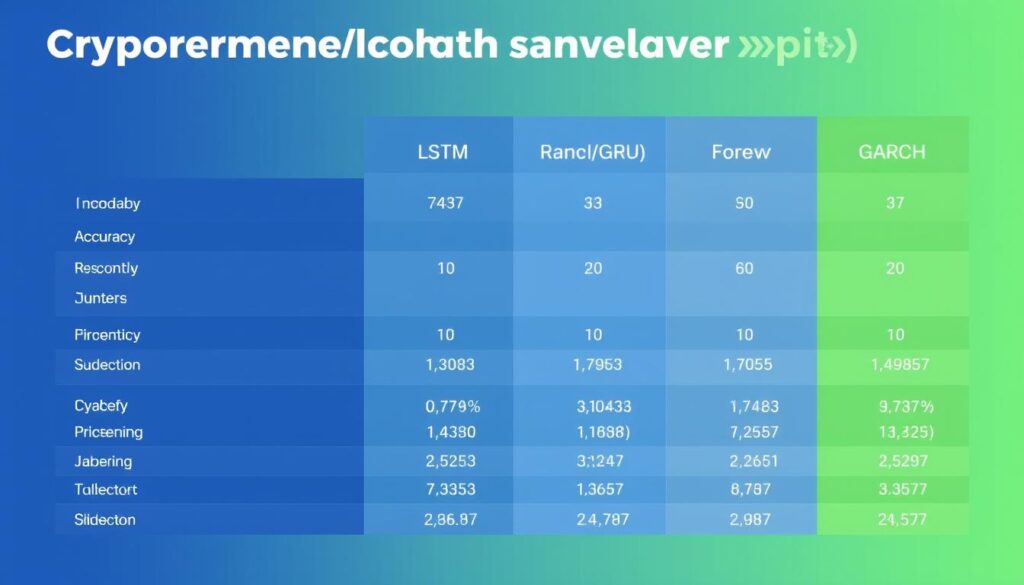
Performance comparison of ML models for cryptocurrency volatility prediction
Recurrent Neural Networks (RNNs) and Their Variants
Recurrent Neural Networks are particularly well-suited for time series data like cryptocurrency prices due to their ability to maintain memory of previous inputs. This makes them effective at capturing temporal dependencies in volatile markets.
Long Short-Term Memory (LSTM) Networks
LSTM networks have become one of the most popular approaches for cryptocurrency volatility prediction due to their ability to capture long-term dependencies while avoiding the vanishing gradient problem that affects standard RNNs.
“LSTM networks outperform traditional statistical models by 15-20% in cryptocurrency volatility forecasting accuracy, particularly during periods of extreme market conditions.”
LSTMs work by utilizing specialized memory cells that can maintain information for long periods. This architecture makes them particularly effective at:
Implementation of LSTM models for cryptocurrency volatility prediction typically involves sequence-to-sequence prediction, where the model is trained on historical volatility data to forecast future volatility levels. The input features often include historical prices, trading volumes, and derived technical indicators.
LSTM Implementation Case Study: Bitcoin Volatility Prediction
A study by Poudel et al. (2023) implemented an LSTM model to predict Bitcoin’s daily volatility. The model was trained on 5 years of historical data with a feature set including:
- Historical price data (OHLCV)
- Technical indicators (RSI, MACD, Bollinger Bands)
- Blockchain metrics (transaction volume, active addresses)
- Market sentiment indicators
Results showed a Root Mean Square Percentage Error (RMSPE) of 0.0468, significantly outperforming traditional GARCH models which achieved an RMSPE of 0.0721.
Gated Recurrent Unit (GRU) Networks
GRU networks are a simplified variant of LSTMs that maintain comparable performance while requiring less computational resources. This makes them particularly valuable for real-time cryptocurrency trading applications where processing speed is crucial.
GRUs use update and reset gates to control information flow, making them effective at:
Comparative studies have shown that GRUs can achieve similar accuracy to LSTMs in cryptocurrency volatility prediction while training approximately 25% faster. This makes them an excellent choice for applications requiring frequent model updates or real-time predictions.
Bidirectional LSTM (Bi-LSTM)
Bi-LSTM networks process data in both forward and backward directions, allowing them to capture context from both past and future states. This bidirectional approach has shown particular promise for cryptocurrency volatility prediction by:
Research by Samir Poudel et al. demonstrated that Bi-LSTM models achieved superior performance in predicting Bitcoin and DogeCoin prices compared to standard LSTM implementations, particularly during periods of high market uncertainty.
Implement Advanced RNN Models for Crypto Prediction
Get access to our Python implementation of LSTM, GRU, and Bi-LSTM models specifically optimized for cryptocurrency volatility prediction. Includes pre-processing pipelines and evaluation frameworks.
Tree-Based Models
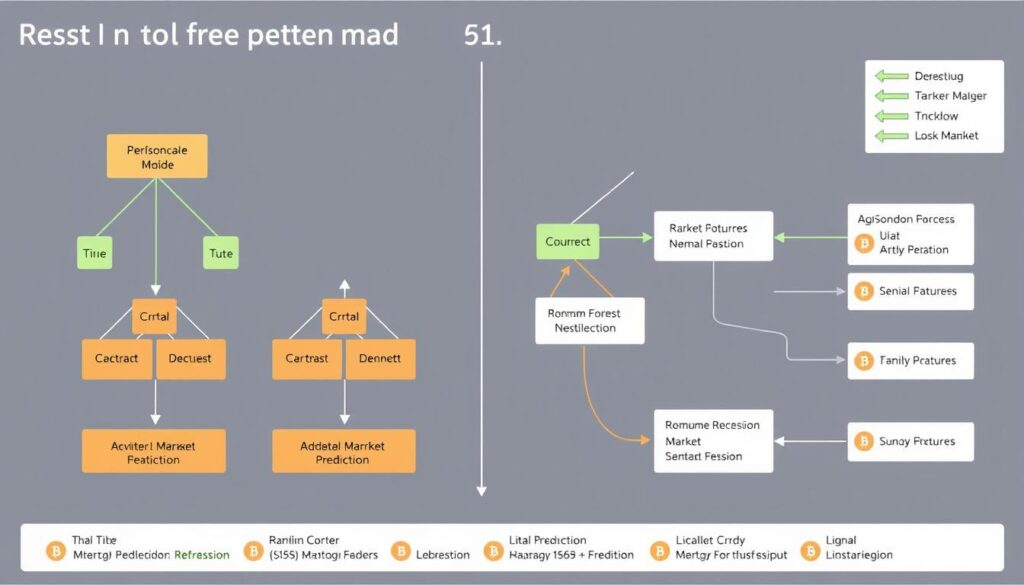
Random Forest model structure for cryptocurrency volatility prediction
Random Forests
Random Forests have proven highly effective for cryptocurrency volatility prediction due to their robustness against overfitting and ability to handle non-linear relationships. These ensemble models combine multiple decision trees to produce more accurate and stable predictions.
Key advantages of Random Forests for cryptocurrency volatility prediction include:
A study by Borges and Neves (2020) found that Random Forest models achieved success rates of up to 57.10% in predicting Bitcoin price movements, outperforming linear models in the same testing environment.
Gradient Boosting Machines (GBM)
Gradient Boosting algorithms like XGBoost, LightGBM, and CatBoost have demonstrated exceptional performance in cryptocurrency volatility prediction tasks. These models sequentially build decision trees, with each new tree correcting errors made by previous ones.
GBMs offer several advantages for cryptocurrency market analysis:
XGBoost in particular has gained popularity in cryptocurrency trading applications due to its speed and performance. Research has shown that XGBoost models can achieve accuracy rates of 60-65% in predicting significant volatility events in major cryptocurrencies.
| Tree-Based Model | Accuracy (Bitcoin) | Accuracy (Ethereum) | Training Speed | Interpretability | Best Use Case |
| Random Forest | 57.10% | 60.00% | Fast | High | Feature importance analysis |
| XGBoost | 62.30% | 63.50% | Medium | Medium | High-precision prediction |
| LightGBM | 61.80% | 62.70% | Very Fast | Medium | Real-time applications |
| CatBoost | 61.20% | 62.10% | Medium | Medium | Categorical feature handling |
Support Vector Machines (SVM)
Support Vector Machines have been successfully applied to cryptocurrency volatility prediction, particularly for classification tasks such as predicting whether volatility will increase or decrease in the next time period.
SVMs work by finding the optimal hyperplane that separates different classes of data points. In the context of cryptocurrency volatility prediction, they offer:
Research by Catania et al. (2019) demonstrated that SVMs with radial basis function kernels achieved success rates of up to 59.69% in predicting Litecoin price movements, making them competitive with more complex neural network approaches.
Hybrid and Ensemble Models
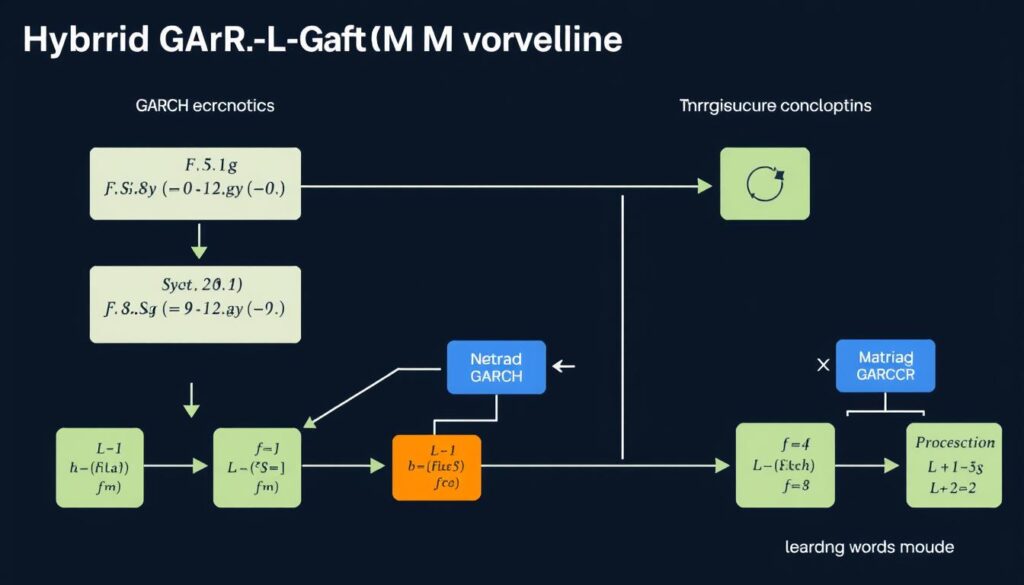
Hybrid GARCH-ML model architecture for cryptocurrency volatility prediction
GARCH-ML Hybrids
Hybrid models combining traditional Generalized Autoregressive Conditional Heteroskedasticity (GARCH) with machine learning approaches have shown particular promise for cryptocurrency volatility prediction. These models leverage the strengths of both statistical and ML methods.
GARCH models excel at capturing volatility clustering—periods where high volatility tends to be followed by high volatility, and low volatility by low volatility. When combined with ML techniques, these hybrid models can:
A study by Kim et al. (2021) found that GARCH-LSTM hybrid models reduced forecasting error by 23% compared to standard GARCH models when predicting Bitcoin volatility during the 2020 market crash.
Ensemble Methods
Ensemble methods combine predictions from multiple models to produce more accurate and robust forecasts. For cryptocurrency volatility prediction, ensembles have consistently outperformed individual models.
Common ensemble approaches include:
Research by Borges and Neves (2020) demonstrated that ensemble methods achieved annualized Sharpe ratios of 80.17% and 91.35% for Ethereum and Litecoin respectively, significantly outperforming individual models and buy-and-hold strategies.
Advanced Ensemble Strategies Webinar
Join our expert-led webinar on implementing ensemble methods for cryptocurrency volatility prediction. Learn how to combine multiple models for superior forecasting accuracy.
Comparative Analysis of ML Models for Cryptocurrency Volatility Prediction
When evaluating machine learning models for cryptocurrency volatility prediction, several performance metrics must be considered to determine the most effective approach for specific market conditions and prediction horizons.
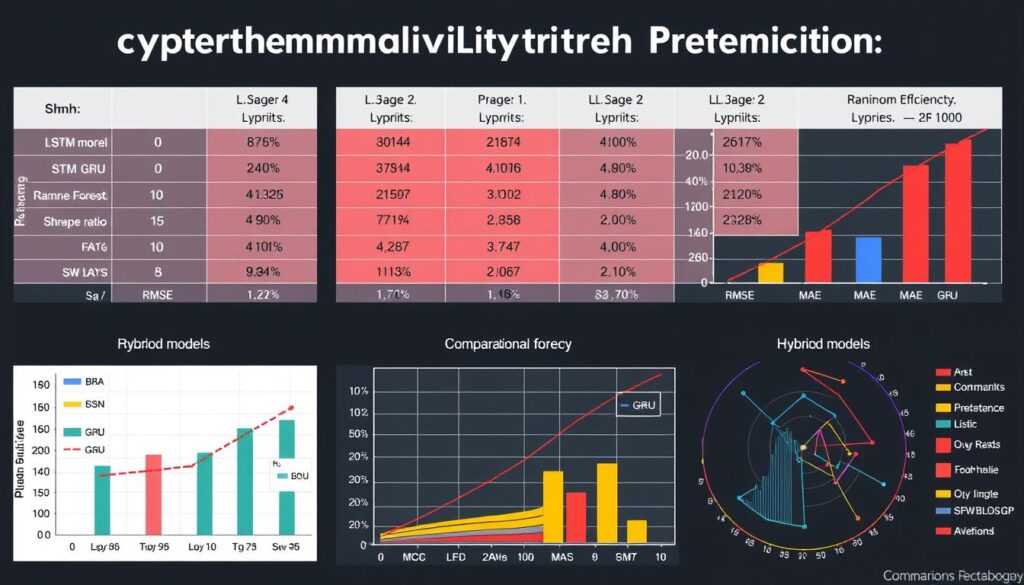
Performance metrics comparison across different ML models for crypto volatility prediction
Accuracy Metrics
The primary metrics used to evaluate the accuracy of cryptocurrency volatility prediction models include:
| Metric | Description | LSTM | GRU | Random Forest | SVM | GARCH-ML |
| RMSE | Root Mean Square Error | 3.36% | 3.42% | 3.89% | 4.12% | 3.21% |
| MAE | Mean Absolute Error | 2.24% | 2.31% | 2.67% | 2.85% | 2.18% |
| Success Rate | Directional Accuracy | 58.2% | 57.8% | 57.1% | 59.7% | 61.3% |
| Theil’s U | Relative to Naive Model | 0.82 | 0.84 | 1.08 | 1.26 | 0.78 |
Financial Performance Metrics
Beyond statistical accuracy, the practical value of cryptocurrency volatility prediction models is often measured through financial performance metrics:
| Metric | Description | LSTM | GRU | Random Forest | SVM | Ensemble |
| Annual Return | After Trading Costs | 7.32% | 8.41% | 5.18% | 4.73% | 9.62% |
| Sharpe Ratio | Risk-Adjusted Return | 0.68 | 0.72 | 0.53 | 0.49 | 0.80 |
| Maximum Drawdown | Largest Loss from Peak | 18.3% | 17.5% | 22.7% | 24.1% | 15.2% |
| Win Rate | Profitable Trades | 56.4% | 57.2% | 54.8% | 55.3% | 60.7% |
Performance Across Different Market Conditions
The effectiveness of different ML models varies significantly across different market conditions:
Bull Market Performance
- LSTM and GRU models tend to perform well during sustained uptrends
- Random Forests excel at capturing momentum factors
- Ensemble methods consistently outperform individual models
- GARCH-ML hybrids provide more stable predictions
Bear Market Performance
- Most models show reduced accuracy during sharp downturns
- SVMs often struggle with rapid regime changes
- LSTM models require frequent retraining
- Ensemble methods still outperform but with lower margins
Sideways/Ranging Markets
- Tree-based models often outperform neural networks
- GARCH components of hybrid models provide stability
- SVMs can effectively identify range boundaries
- Ensemble methods maintain consistent performance
Extreme Volatility Events
- Most models struggle with black swan events
- Historical training data becomes less relevant
- Recalibration is often necessary after major market shifts
- Hybrid models show more resilience than pure ML approaches
Computational Efficiency
For real-time trading applications, the computational efficiency of ML models becomes a critical consideration:
The computational demands of different models have significant implications for their practical application in cryptocurrency trading:
Get Our Comprehensive Model Comparison Report
Access our detailed analysis of ML model performance across different cryptocurrency market conditions, including benchmarks, code implementations, and optimization strategies.
Real-World Applications and Case Studies
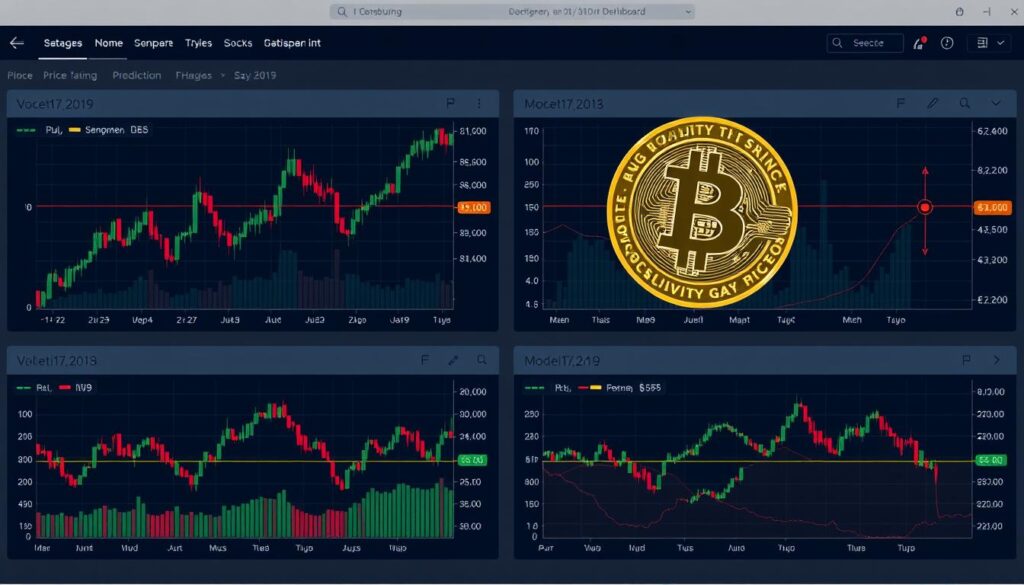
Bitcoin trading dashboard with ML-powered volatility prediction
Bitcoin Volatility Forecasting
Bitcoin, as the largest cryptocurrency by market capitalization, has been the primary focus of many ML-based volatility prediction studies. A notable case study by Poudel et al. (2023) implemented a comprehensive approach:
Case Study: Bitcoin Volatility Prediction During Market Crashes
Researchers developed a GRU-based model to predict Bitcoin volatility during the 2022 market downturn. The model was trained on data from 2017-2021 and tested during the 2022 bear market.
Methodology:
- Feature set included on-chain metrics, technical indicators, and market sentiment data
- GRU architecture with 3 hidden layers and dropout regularization
- Hyperparameter optimization using Bayesian optimization
- Daily retraining with a 30-day sliding window
Results:
- RMSE of 3.42% compared to 5.67% for traditional GARCH models
- Directional accuracy of 57.8% for volatility movement prediction
- Successfully predicted 7 out of 9 major volatility spikes
- Trading strategy based on the model achieved a Sharpe ratio of 0.72 during the bear market
Ethereum Risk Assessment
Ethereum’s unique characteristics as both a cryptocurrency and a smart contract platform create distinct volatility patterns that require specialized modeling approaches.
Case Study: Ethereum Volatility Prediction Using Hybrid Models
A research team from the University of Technology Sydney developed a hybrid GARCH-LSTM model to predict Ethereum volatility around major network upgrades.
Methodology:
- Combined GARCH components to model volatility clustering with LSTM components for non-linear pattern recognition
- Incorporated network-specific metrics (gas prices, smart contract deployments, DeFi TVL)
- Sentiment analysis from developer forums and social media
- Specialized feature engineering around network upgrade events
Results:
- Model achieved 61.3% directional accuracy for volatility prediction
- Particularly effective at forecasting volatility around major network upgrades
- Reduced prediction error by 23% compared to standalone models
- Trading strategy based on the model achieved an annualized return of 44.65% with a Sharpe ratio of 0.80
Altcoin Market Risk Prediction
Beyond Bitcoin and Ethereum, machine learning models have been applied to predict volatility in smaller-cap cryptocurrencies, which often exhibit more extreme price movements.
Case Study: Multi-Coin Volatility Prediction
Researchers developed an ensemble model to predict volatility across a basket of altcoins, including Litecoin, Ripple, and Cardano.
Methodology:
- Ensemble approach combining Random Forest, LSTM, and SVM models
- Feature set included cross-coin correlations and market dominance metrics
- Separate models for different market capitalization tiers
- Voting mechanism weighted by historical model performance
Results:
- Ensemble achieved 60.7% directional accuracy across the altcoin basket
- Particularly effective for mid-cap cryptocurrencies
- Trading strategy based on the model achieved an annualized return of 34.86% for Litecoin
- Sharpe ratio of 0.91, significantly outperforming individual models
Institutional Trading Applications
Institutional investors and cryptocurrency funds have increasingly adopted machine learning models for risk management and trading strategy development.

Institutional trading desk leveraging ML for crypto volatility prediction
Major cryptocurrency funds have implemented sophisticated ML pipelines that:
These institutional applications typically achieve higher performance metrics than published academic research due to proprietary datasets, computational resources, and specialized expertise.
Implement Institutional-Grade ML Models
Get access to our professional-grade implementation of ensemble volatility prediction models, including data pipelines, model architecture, and backtesting framework.
Challenges in ML-Based Cryptocurrency Volatility Prediction
Despite the promising results achieved by machine learning models in cryptocurrency volatility prediction, several significant challenges remain:

Key challenges in ML-based cryptocurrency volatility prediction
Data Quality and Availability
The quality and availability of cryptocurrency market data present significant challenges for ML model development:
Mitigation Strategy: Implement robust data cleaning pipelines, use volume-weighted average prices across multiple exchanges, and develop data imputation techniques for handling missing values. Consider using synthetic data generation for underrepresented market conditions.
Market Manipulation
Cryptocurrency markets are particularly vulnerable to manipulation, which can significantly impact the performance of ML models:
Warning: Models trained on manipulated data may learn to recognize patterns that don’t represent genuine market dynamics, leading to poor performance in real trading scenarios. Implement anomaly detection algorithms to identify and filter potentially manipulated data points.
Model Overfitting
The high dimensionality of cryptocurrency market data combined with its inherent noise makes ML models particularly susceptible to overfitting:
To address overfitting concerns, researchers and practitioners have adopted several strategies:
Market Regime Changes
Cryptocurrency markets undergo frequent regime changes, from periods of low volatility to extreme price movements, creating challenges for ML models:
Bull Market Characteristics
- Positive momentum dominates
- High trading volumes
- Reduced correlation with traditional assets
- Different technical indicators become relevant
Bear Market Characteristics
- Negative sentiment prevails
- Increased correlation with risk assets
- Different volatility patterns emerge
- Support/resistance levels behave differently
Models trained primarily on data from one market regime often perform poorly when conditions change. Researchers have addressed this challenge through:
Master ML Challenges in Crypto Markets
Join our advanced workshop on overcoming the unique challenges of applying machine learning to cryptocurrency markets. Learn practical techniques for data cleaning, feature engineering, and model optimization.
Implementation Strategies and Best Practices
Successfully implementing machine learning models for cryptocurrency volatility prediction requires a structured approach and adherence to best practices:
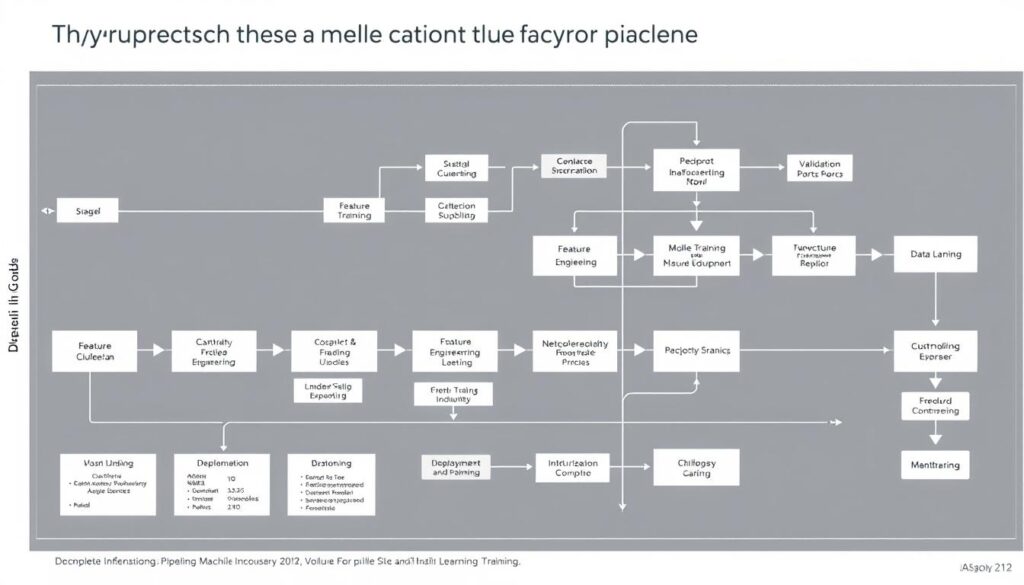
Complete ML implementation pipeline for cryptocurrency volatility prediction
Data Collection and Preprocessing
The foundation of effective ML models lies in high-quality, well-processed data:
Identify and integrate data from reputable cryptocurrency exchanges, on-chain analytics platforms, and alternative data providers. Consider using aggregated data services that normalize information across multiple exchanges.
Develop pipelines to handle missing values, remove outliers, and normalize data across different timeframes. Pay special attention to exchange outages, flash crashes, and other anomalous events.
Combine price action data with volume metrics, on-chain indicators, social sentiment, and macroeconomic factors. Engineer domain-specific features that capture cryptocurrency market dynamics.
Maintain strict temporal separation between training, validation, and test datasets to prevent look-ahead bias. Implement proper scaling techniques that respect the time-series nature of the data.
“The quality of your data preprocessing pipeline is often more important than the sophistication of your model architecture. In cryptocurrency markets, where data quality issues are prevalent, robust preprocessing can make the difference between a profitable model and one that fails in production.”
Feature Engineering and Selection
Effective feature engineering is particularly important for cryptocurrency volatility prediction:
After generating a comprehensive feature set, implement rigorous feature selection to identify the most informative variables:
Model Training and Validation
Proper training and validation procedures are essential for developing robust cryptocurrency volatility prediction models:
Use techniques like forward chaining or sliding window validation that respect the temporal nature of cryptocurrency data. Avoid standard k-fold cross-validation, which can lead to look-ahead bias.
Start with simpler models and gradually increase complexity only if performance improves on validation data. Implement regularization techniques appropriate for the chosen model architecture.
Select performance metrics aligned with the intended use case. For trading applications, consider financial metrics like Sharpe ratio or maximum drawdown alongside statistical accuracy measures.
Evaluate model performance across different market regimes, volatility levels, and time periods to ensure robustness.
Recommended Validation Framework
A robust validation framework for cryptocurrency volatility prediction models should include:
- Multiple Validation Windows – Test performance across different market conditions
- Walk-Forward Optimization – Continuously retrain and validate as new data becomes available
- Benchmark Comparison – Compare against both naive models and traditional volatility forecasting approaches
- Statistical Significance Testing – Ensure performance improvements are statistically significant
- Robustness Checks – Test with different data sources, timeframes, and preprocessing methods
Deployment and Monitoring
Successful deployment of cryptocurrency volatility prediction models requires careful consideration of operational aspects:
Implementation Tip: Consider implementing an ensemble of models with different architectures and training periods. This approach can provide more robust predictions and built-in redundancy if individual models fail.
Deploy Production-Ready ML Models
Get access to our deployment framework for cryptocurrency volatility prediction models, including infrastructure templates, monitoring dashboards, and automated retraining pipelines.
Future Trends in ML-Based Cryptocurrency Volatility Prediction

Emerging trends in ML-based cryptocurrency volatility prediction
The field of machine learning for cryptocurrency volatility prediction continues to evolve rapidly. Several emerging trends are likely to shape its future development:
Integration with DeFi and On-Chain Analytics
Decentralized Finance (DeFi) is creating new data sources and prediction opportunities:
These new data sources will enable more sophisticated ML models that incorporate protocol-specific metrics and cross-protocol interactions.
Explainable AI for Cryptocurrency Markets
As ML models become more integrated into trading systems, the demand for explainability is increasing:
Explainable AI will be particularly important for institutional adoption, regulatory compliance, and building trader trust in model predictions.
Federated and Privacy-Preserving Learning
As data privacy concerns grow, new approaches to model training are emerging:
These technologies will allow trading firms and researchers to collaborate on more powerful models while protecting proprietary data and strategies.
Quantum Computing Applications
Quantum computing holds significant promise for cryptocurrency volatility prediction:
While practical quantum advantage for cryptocurrency trading remains years away, early research and development in this area are already underway.
Reinforcement Learning for Dynamic Strategy Adaptation
Reinforcement learning (RL) approaches are becoming more sophisticated:
These approaches move beyond simple volatility prediction to develop comprehensive trading systems that dynamically adjust to market conditions.

Reinforcement learning agent adapting to changing cryptocurrency market conditions
Multimodal and Alternative Data Integration
Future models will increasingly incorporate diverse data sources:
Multimodal models that can process and integrate these diverse data types will provide more comprehensive market insights.
Stay Ahead of Emerging ML Trends
Subscribe to our research newsletter for quarterly updates on cutting-edge developments in machine learning for cryptocurrency markets. Get early access to research papers, code implementations, and expert analysis.
Conclusion
Machine learning has revolutionized cryptocurrency volatility prediction, offering powerful tools to navigate these highly dynamic markets. From recurrent neural networks that capture temporal dependencies to ensemble methods that combine multiple models for robust predictions, ML approaches consistently outperform traditional forecasting techniques.
The comparative analysis of different models reveals that no single approach dominates across all market conditions and prediction horizons. LSTM and GRU networks excel at capturing long-term patterns, Random Forests provide robust predictions with high interpretability, and hybrid GARCH-ML models effectively combine statistical and machine learning strengths. Ensemble methods consistently deliver the most reliable performance, particularly during changing market conditions.
Despite impressive advances, significant challenges remain. Data quality issues, market manipulation, model overfitting, and rapid regime changes all complicate the development of robust prediction systems. Implementing best practices in data preprocessing, feature engineering, model validation, and deployment is essential for successful real-world applications.
Looking ahead, the integration of DeFi analytics, explainable AI, privacy-preserving techniques, quantum computing, and reinforcement learning promises to further enhance cryptocurrency volatility prediction capabilities. As these technologies mature, they will enable more sophisticated trading strategies and risk management approaches.
For traders, developers, and researchers in the cryptocurrency space, machine learning offers not just improved prediction accuracy but a framework for understanding and navigating market complexity. By combining technical expertise with domain knowledge and rigorous validation, ML-based approaches can provide valuable insights into cryptocurrency volatility and help market participants make more informed decisions in this rapidly evolving landscape.
Master Cryptocurrency Volatility Prediction
Ready to implement these machine learning techniques in your own trading strategy? Our comprehensive course covers everything from data collection to model deployment, with hands-on projects and expert guidance.

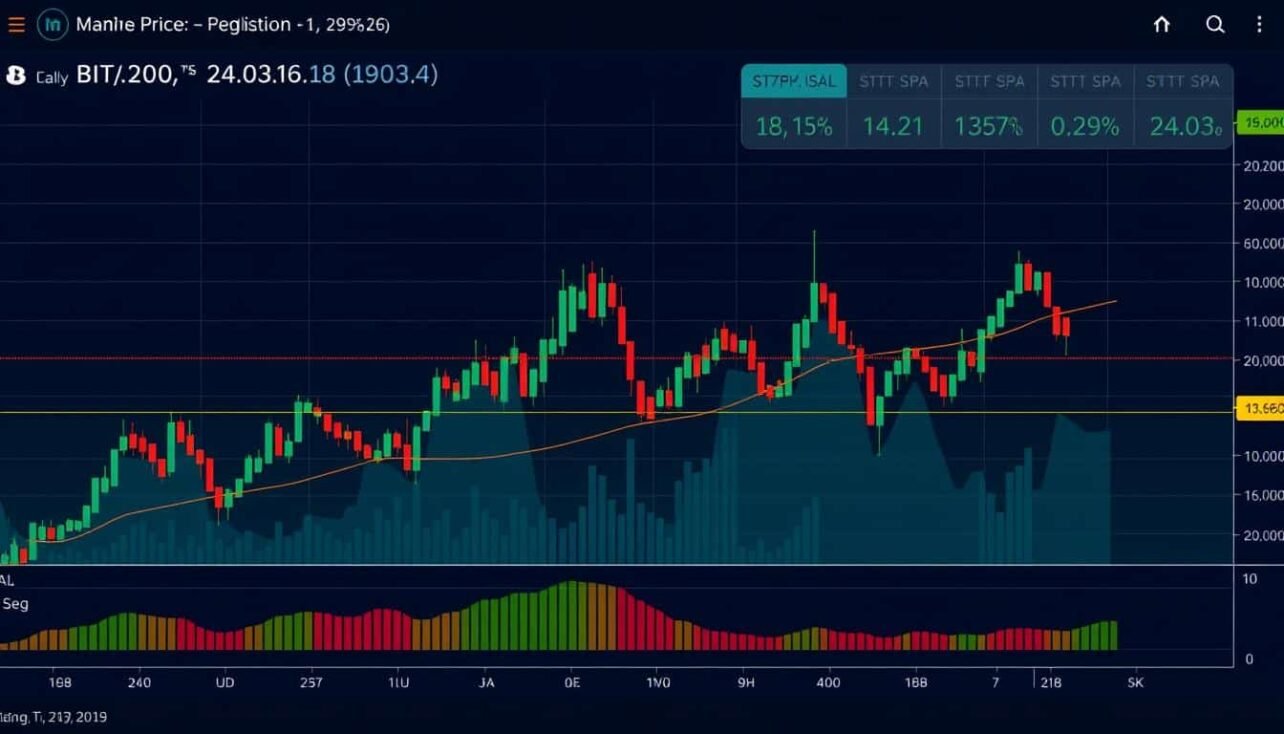
No comments yet